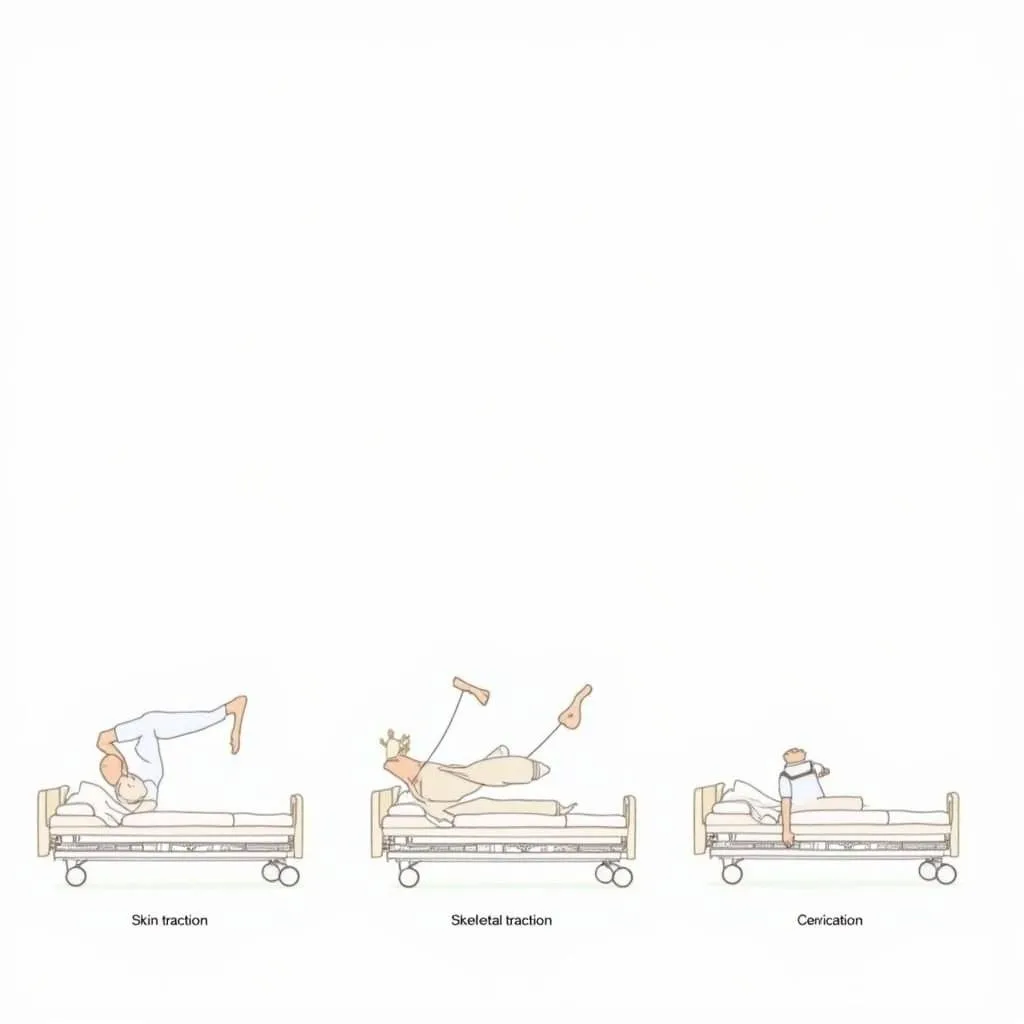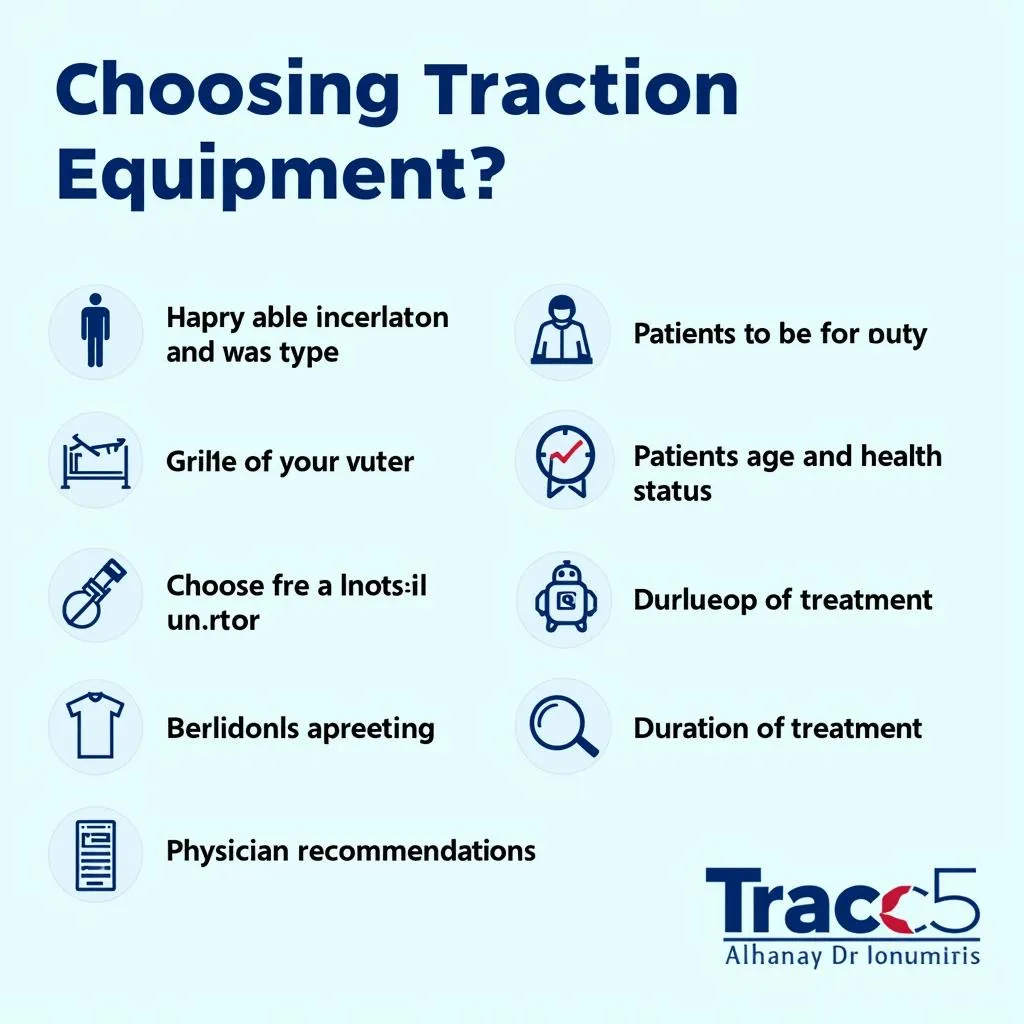Traction Equipment For Hospital Beds plays a crucial role in modern healthcare settings, providing essential support for patients recovering from surgery, injuries, or chronic conditions. This specialized equipment helps immobilize and stabilize specific body parts, facilitating healing, pain management, and overall patient well-being.
Understanding Traction Equipment
Traction equipment utilizes a system of weights, pulleys, and frames to create a gentle but consistent pulling force on the affected area. This controlled traction helps:
- Reduce muscle spasms: Traction relieves muscle tension and spasms, which are common after injuries or surgeries.
- Align bones: By gently pulling fractured or dislocated bones, traction equipment aids in proper alignment, promoting optimal healing.
- Decompress joints: Traction can alleviate pressure on compressed nerves and joints, reducing pain and inflammation.
- Improve blood circulation: The gentle pulling force promotes blood flow to the injured area, facilitating the delivery of oxygen and nutrients essential for healing.
Types of Traction Equipment for Hospital Beds
There are various types of traction equipment available, each designed for specific applications and patient needs. Some common types include:
- Skin traction: This non-invasive method uses straps, bandages, or boots applied directly to the skin. Weights attached to the equipment provide the necessary pulling force. Skin traction is often used for short-term treatment and pain relief.
- Skeletal traction: This method involves surgically inserting pins, wires, or screws into the bone. These fixation devices are then connected to the traction equipment, allowing for greater pulling force and more precise alignment. Skeletal traction is typically reserved for more severe injuries or fractures requiring prolonged immobilization.
- Cervical traction: This specialized traction targets the neck region to address conditions like cervical spondylosis or whiplash. It typically involves a head halter connected to a weight system, gently stretching the neck and relieving pressure on nerves.
 Different types of traction equipment for hospital beds
Different types of traction equipment for hospital beds
Benefits of Using Traction Equipment
Incorporating traction equipment into patient care offers numerous benefits:
- Enhanced Patient Comfort: By reducing pain, muscle spasms, and pressure on nerves, traction equipment significantly improves patient comfort during recovery.
- Improved Healing Outcomes: Proper alignment and immobilization facilitated by traction promote faster and more effective healing of injuries and fractures.
- Reduced Need for Pain Medication: As traction effectively manages pain, it can decrease the reliance on pain medications, minimizing potential side effects and promoting faster recovery.
- Increased Patient Mobility: While traction aims to immobilize specific body parts, it can also indirectly improve overall mobility by reducing pain and stiffness.
Choosing the Right Traction Equipment
Selecting the appropriate traction equipment depends on several factors, including:
- Type and severity of the injury or condition
- Patient’s age, weight, and overall health status
- Duration of treatment required
- Physician’s recommendations and treatment plan
 Factors to consider when selecting traction equipment for a hospital bed
Factors to consider when selecting traction equipment for a hospital bed
Safety Considerations
While traction equipment is generally safe, adhering to safety precautions is crucial:
- Regularly inspect equipment: Ensure all components, including ropes, pulleys, weights, and frames, are in good working condition.
- Maintain proper weight application: Follow the physician’s instructions regarding the amount of weight to apply, as excessive weight can be detrimental.
- Monitor patient’s response: Observe the patient for any signs of discomfort, pain, or skin irritation. Promptly address any concerns with the healthcare team.
- Provide patient education: Educate patients on the purpose, function, and safety precautions associated with traction equipment.
Conclusion
Traction equipment for hospital beds remains an invaluable tool in healthcare, promoting patient comfort, facilitating healing, and improving overall outcomes. By understanding the different types, benefits, and safety considerations, healthcare providers can make informed decisions to optimize patient care and enhance their recovery journey.
FAQs
1. How long will I need to use traction equipment?
The duration of traction use varies depending on the individual’s condition and treatment plan. Your doctor will determine the appropriate length of time based on your specific needs.
2. Will I be able to move around while using traction equipment?
While traction aims to immobilize the injured area, your healthcare team will encourage limited and safe movements to prevent stiffness and promote circulation.
3. Is traction painful?
Traction is usually not painful when applied correctly. You may feel a gentle pulling sensation, but it should not be unbearable. If you experience any pain, inform your nurse or doctor immediately.
4. What are the alternatives to traction?
Alternatives to traction include immobilization with casts, splints, or braces, pain management with medication or physical therapy, and surgical interventions in certain cases.
5. Can I use traction equipment at home?
In some cases, your doctor may recommend using traction equipment at home for a short period. They will provide instructions on proper use and safety precautions.
Need Assistance?
At San Jose Hospital, our dedicated team of healthcare professionals is committed to providing exceptional care and support throughout your recovery journey. If you have any questions or require assistance regarding traction equipment for hospital beds, please do not hesitate to contact us:
Phone Number: 02437655121
Email: [email protected]
Address: Số 298 Đ. Cầu Diễn, Minh Khai, Bắc Từ Liêm, Hà Nội, Việt Nam.
We offer 24/7 customer support and are here to address your needs with compassion and expertise.